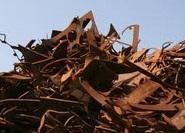Market

April 9, 2020
Ferrous Scrap Prices Looking Down $30-50 in April
Written by Tim Triplett
With much of U.S. manufacturing on hold to control the spread of the coronavirus, it’s no surprise that steel production and demand for scrap are substantially lower than last month. Ferrous scrap prices are generally trading down $50 per ton for obsolete grades and $30 per ton for prime grades in April, reported Steel Market Update sources, though trading was ongoing as of Thursday. Whatever the final figures, scrap prices will be significantly lower and add further downward pressure to finished steel prices.
“While scrap demand is substantially weaker month over month, scrap supply has dried up and the export market has risen to the point where dealers have pushed back on these lower scrap prices,” said CRU Senior Analyst Ryan McKinley.
Stay-at-home orders by state and local governments to control the spread of Covid-19 have squeezed scrap supplies. Dealers in most regions have completely shut off their peddler intake, lowered scale prices and reduced shredder operations. The shutdown of automotive and other manufacturing facilities has severely cut prime grade supplies as well. Scrap flows into dealers’ yards are down 50-70 percent by some estimates, McKinley said.
Government assistance for small business owners has provided cash flow for scrap operators, giving some the cushion they need to refuse to sell scrap at down $30-50. In addition, a rebound in the export market of $30-40 per ton in the second week of April has many reluctant to sell into a down domestic market. Nevertheless, demand will continue to deteriorate and supply will remain constrained in the coming months, making further declines in scrap prices likely in May, said McKinley.
“Pricing is still fluid in many parts of the country with sales not completed and the largest consumer not even entering the market as of yet,” said one scrap executive on Thursday afternoon. “Certain mills did announce down $30-50, but the market is much more nuanced and, broadly speaking, higher priced. Support is marginal at these levels and scrap was bought mainly from scrap-soft regions such as Chicago and Canada. Mills to the east and south bought obsolete grades at down $35-40 and primes down $20. At this writing, prime scrap is now being quoted down $10 to sideways as there is simply very little prime available and the outlook for the generation of prime scrap in May is dismal,” he added.
“This April market is highly unusual. How one trades it really depends on your perception of timing and the inevitable supply squeeze for scrap that’s coming,” said another dealer in the Northeast, who offered the following assessment:
“From dealers’ perspective, the supply pipeline is as thin as it’s ever been due to many yard closures. They are shipping scrap on old orders, and some may have minimal tons to ship on new orders. For the scrap that they are buying, we are seeing some dealers raise prices to stimulate flows, particularly for shredder raw material feedstock.
“Dealers have also watched the export market rise over the last 48-72 hours, despite the uncertain next moves that may come. For now, with export prices about $30 off the bottom last week, dealers have a little more confidence. Prime scrap remains tight because of many manufacturing plant closures, including of course the auto plants. Many dealers have applied for Paycheck Protection Program assistance, and even if they have not gotten the money yet, this has given them a little more assurance that they don’t need to commit to selling scrap today.
“The bottom line is that many dealers are able to wait and see what happens rather than commit any meaningful tons to orders they will have to fill at low margins. They understand the situation for mills is equally uncertain, and that demand for scrap in May could potentially be even worse, but that is a bridge they can cross then. They know there is a good chance that sometime in May the market will begin to rise again as mills will need to replenish their scrap supply pipelines.
“Mills and their brokerage firm buying arms have been rather quiet. Most mills will buy obsoletes today at down $40-50 and primes at down $30 from March prices, but I don’t really think there is a lot of trading going on at those numbers. Mill demand is weak because the mills don’t want to take scrap risk at this point, irrespective of whether they think these prices present a buying opportunity. There aren’t many dealers who want to sell at current prices.
“We are in a situation where scrap supply and demand are disconnected. The supply side is easier to grasp right now, as it’s extremely tight and there are no inflows across the chain. The demand side is uncertain and certainly weak, but maybe not as weak as supply. But they will have to reconnect again, and when they do, I expect scrap prices to be better than they are today.”
Commented another SMU source: “The market is definitely down, but with little buying, putting grades in the Detroit area at $260/GT for busheling, $220 for shredded and $190-200 for HMS. However, Detroit mills bought very little so prices are higher elsewhere and dealers are generally reluctant to sell at these lower numbers.
“The export markets have rallied very rapidly over the last week. Prices into Turkey and surrounding countries have risen from a low for British/Baltic scrap of $205/MT to a recent high for a U.S. cargo at $245/MT CFR for HMS. That’s up $40 in a week as Turkish mills realized there won’t be much left to buy if they don’t tie things up now.”
Pig Iron Market
“The pig iron market has dropped some, but not nearly as much as scrap. The Chinese have bought numerous cargoes in southern Brazil at prices of about $297-300/MT FOB. The Russian/CIS producers also sold 4-5 cargoes to China as well, priced at $330-335/MT CFR. The latest activity reported was a new Chinese buy or renegotiation at a price of $280 MT CFR, which of course would be down, though this is not official. The offer price to the U.S. mills should be in the range of $320-325/MT CFR. U.S. mills have not actively been in this market since the virus became an interference,” he added.
The post Ferrous Scrap Prices Looking Down $30-50 in April appeared first on Steel Market Update.






